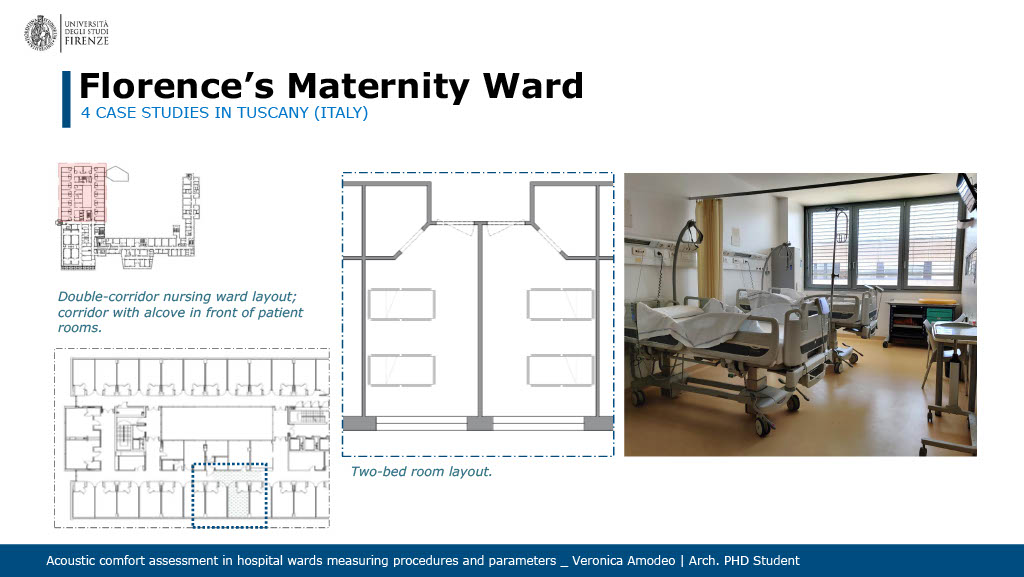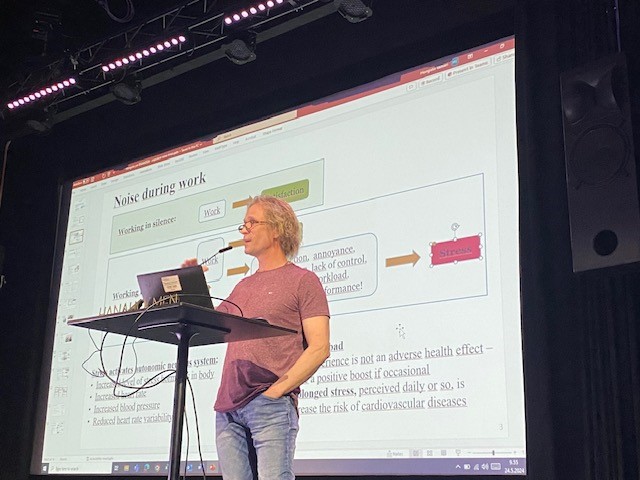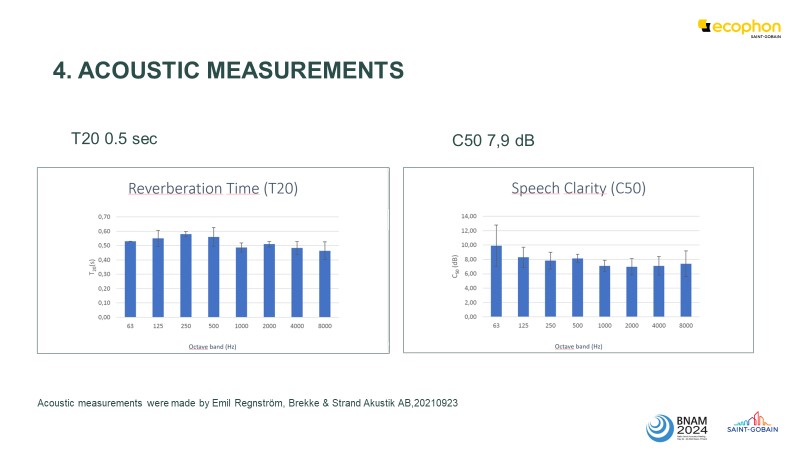
On May 22-24, some 175 delegates from 18 countries gathered together in the beautiful venue at the Finnish-Swedish Cultural Center Hanaholmen. Located at the scenic seafront between Helsinki and Espoo in Finland. This second article will highlight the acoustic meeting presentations regarding Healthcare.
Acoustics and Healthcare
Acoustic comfort assessment in hospital wards: measuring procedures and parameters. Veronica Amodeo
Noise pollution is one of the most concerning environmental factors, as it can affect people’s health. Especially the health of vulnerable people, such as children, the elderly, the sick, or hospitalized. For this reason, special attention must be paid to the design of hospital environments. Noise from different activities and equipment can affect both the performance of healthcare staff and the quality of sleep of patients.

Patients are the most vulnerable users, as their condition leads to less ability to cope with stress and greater sensitivity to noise. Despite numerous scientific studies showing that the noise levels detected within hospitals are highly above those indicated by the World Health Organisation. There are few proposals for effective noise reduction in wards.
The research starts from the need to ensure the acoustic comfort of patients during their hospitalization. The first purpose was to define a replicable survey method for assessing noise and acoustic quality in hospital wards. Using acoustic characterization measurements, sound pressure levels long-time monitoring, and field observations.
The sound-pressure levels detected are heavily exceeding the limits recommended by the World Health Organisation. Several inpatient areas for routine care with two-bed rooms were examined (maternity, surgery, neurorehabilitation and endocrine surgery ward). They were all examined and they varied from having no acoustic treatment to being well treated with favorable reverberation times.

The survey, which can be easily applied to different contexts, has currently been experimented within some Italian University Hospitals. A proposal to study hospital sound sources using a clustering technique will be presented at Internoise in August 2024.
Stress effects of impulsive noise. A medical laboratory experiment, by Valtteri Hongisto
Impulsive sound has been found to annoy people more than steady-state sounds presented at the same LAeq level. The study examined the physiological, performance, and subjective effects of impulsive sound on working humans.

The conditions were impulsive sound (65 dB LAeq), steady-state sound (65 dB), and quiet sound (35 dB). An between-groups design, where each participant was exposed to one sound condition was applied. 59 participants were divided into these three groups.
Physiological stress was measured with stress hormone concentrations in plasma, heart rate variability (HRV), and blood pressure. Psychological stress was measured with subjective noise annoyance, workload, and fatigue estimations. Performance was measured in tasks requiring constant concentration (visual serial recall, auditory serial recall, N-back).
Compared to quiet, impulsive sound caused more annoyance, workload, and lack of energy. Aaised cortisol concentrations, reduced systolic blood pressure, and decreased accuracy in the 3-back task. Compared with steady-state sound, impulsive sound was estimated more annoying and causing a higher workload and lack of energy. Impulsive sound reduced 3-back accuracy while steady-state sound did not.
Part of the effects of impulsive sound were due to the increased sound level since physiological stress reaction was also observed for steady-state sound. However, impulsive sound caused an extra effect over steady-state sound reflected in psychological experience and performance. Special care should be paid to the noise control of impulsive sounds in environments where people are performing mental work!
Acoustics in a modular operating theatre, by Maria Quinn
Construction practices change and modular construction is increasing. Thus possibly affecting the acoustics in healthcare premises. Several factors contribute to the increase in modular construction. Reduced building time, reduction of waste, and less pollution on-site. It can also serve as a temporary solution with all the technical and hygienic demands met as in a traditional operating room (OR). Working conditions in Healthcare can include challenging acoustical issues. For modular constructions, acoustic comfort is not always addressed or considered by modular suppliers.
In the traditional construction way, acoustic comfort and its impact on staff and patients have been well studied. Nevertheless, comfort and work quality are equally affected. Especially in sensitive specialist areas in new modular buildings, whether they are temporary or permanent modular constructions.
This presentation focus on the acoustic measurements and the staff feedback on the modular construction of an OR in Trollhättan, Sweden. This operating department was constructed in merely 6 months following a technical issue with existing operating rooms. It was built as a free standing module on the ground connected to the original hospital via a long passage. It includes 4 operating rooms and adjacent areas.

The operating rooms were treated with 40 mm thick absorption class A ceiling tiles. Covering approximately 80% of the ceiling area. No wall absorption was used. The product comply with all hygiene requirements.
The outcomes show good results on reverberation time complying with the acoustic standard (SS 25268:2023). The speech clarity was 7,9 dB, but the STI was only fair/good probably due to the background noise. The background noise primarily comes from the advanced ventilation system needed to keep the air as particle free as possible. The staff was very content overall with the new operating rooms. But could also see that on a specifically busy day, or in stressed situation, more can be done to create a great sound environment.
Sound levels in symphony orchestra musicians, by Magne Skålevik
A symphony orchestra is a complex and powerful sound source, where musicians are both sources and receivers. Instant levels vary a lot from one moment to another. And equivalent levels varies significantly from piece to piece, from one instrument type to another, from one position to another, from one orchestra to another, from one concert hall to another.
Musicians are often concerned about their hearing and the risk of hearing loss. And at least one orchestra has been convicted legally responsible for the hearing loss of a musician. Different kinds of hearing protection are being used, but they come with downsides. Noise is unwanted sound, while music is not. Still, the sound of music is commonly treated like industrial noise. And its exposure levels compared with limits intended for industry workers. Is this common practice justified? What are the common exposure levels anyway? These and similar questions were highlighted during this very interesting presentation.
Symphonic music can cause instant A-weighted sound pressure levels ranging from 20dB to 140dB, depending on time and position in the room. More details on this can be found in the paper. Also tips and recommendations about individually adapted hearing protection and personal, cautious practice on rehearsals and concerts.
More information
The presentations from BNAM2024 can be found here
Would you like to read more on BNAM conferences, check these links out!

